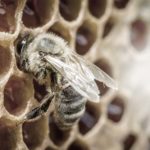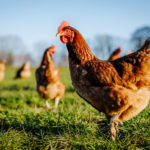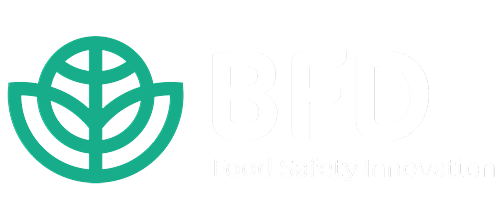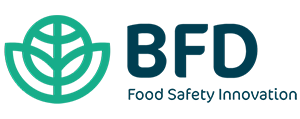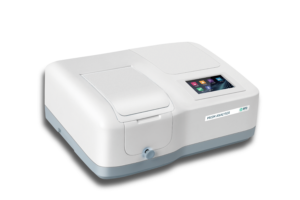
Honey: Day 9 – 12 Days of Food Safety
Day 9: Honey
12 Days of Food Safety
Honey is a versatile and popular ingredient in many festive meals. It adds a natural sweetness and depth of flavour to a variety of dishes, making it a common choice for holiday recipes.
From delicately glazing roast meats like ham and turkey, to enhancing the flavour of side dishes such as parsnips and carrots, the magic of honey unveils itself in a caramelized exterior, bestowing a delightful blend of sweet and savoury notes to every dish.
Yet, honey is more than just a culinary delight; it’s a natural elixir with a multitude of health benefits. Ranging from its nutritional content to its soothing and antioxidant properties, honey has been boasted to elevate digestive health issues and promote natural healing.
Simultaneously, the world of buzzing bees plays a pivotal role in maintaining the delicate balance of ecosystems. Bees, the unsung heroes of our food chain, contribute significantly to global food production through their diligent pollination services. As they flit from flower to flower, they not only ensure bountiful crop yields but also foster biodiversity and support the health of our environment.
According to Faostat, natural honey production reached 1,675,168 tonnes in 2022 with China being the biggest producer generating 461,900 tonnes alone 1. New Zealand, Argentina, India and Ukraine were the next biggest ranking global producers, and combined, these 5 leading suppliers have generated 43.1% of international sales of natural honey in 2022 2.
With such large scale production, consumer preferences are steering trends in the honey industry, with a focus on natural and organic products free from additives and contaminants. The demand for locally sourced and artisanal honey is rising, driven by consumers’ interest in the origin of their food. Raw and unfiltered honey, retaining natural pollen and enzymes, is also gaining popularity for its perceived health benefits. Consumers prioritize sustainable and ethical practices, favouring producers with transparent information regarding product quality and authenticity.
Honey Testing
In the intricate journey from hive to jar, honey is susceptible to various challenges, with the potential for contamination at multiple stages—be it during production, processing, or packaging. This susceptibility introduces unwelcome elements such as pesticides, heavy metals, antibiotics, and environmental pollutants. Consequently, it becomes imperative for the industry to conduct thorough testing on their products. This rigorous testing is not just a precautionary measure; it’s a necessity to ensure that honey aligns with the stringent food safety regulations and standards established by authorities.
Below are a few examples of testing carried out by the honey industry:
Antibiotic Residue Testing:
Honey is tested for the presence of antibiotic residues to ensure compliance with regulations. The use of antibiotics in beekeeping can lead to residues in honey and can impact consumer health and cause antibiotic resistance concerns. The Biorex Food Diagnostics Honey Testing Panel table shows the most prevalent antibiotics required by regulatory bodies to be tested.
Pesticide Residue Testing:
Pesticides can find their way into honey through various routes, including the use of pesticides in agriculture near beekeeping areas. Bees may also come into contact with pesticides during their foraging activities. Testing is conducted for the presence of pesticide residues to ensure compliance with regulations.
Sugar Testing:
Monosaccharides fructose and glucose are sugars found at very high concentrations in honey. Sucrose (disaccharide) is the main sugar contained in nectar and honeydew of plants, while it is often a component of honey, it is only found in small concentrations. All unifloral honey with the exception of Rape (Brassica napus) should have Fructose/Glucose (F/G) ratio ≥1.0, while Acacia F/G ratio can be as high as 1.5-1.5. If F/G ratio is lower ratio than 1, this could suggest adulteration with syrups or honey has been treated using ion exchange resins to remove antibiotics/pesticides. European legislation sets the maximum sucrose content in honey at 5g/100g, with total sugars (glucose/fructose) >60g/100g (nectar honey) and >40g/100g (honeydew honey).
Pollen Analysis:
Pollen analysis helps identify the floral sources of honey. It is a crucial test for verifying the authenticity of honey and ensuring it has not been adulterated with other sweeteners. As honey is a natural product with unique properties, its quality can be influenced by various factors such as processing and storage conditions.
Hydroxymethylfurfural (HMF) Testing:
HMF (5-hydroxymethylfurfural) is a compound formed during heat treatment applied to honey during the processing and bottling of the product. Generally, HMF is not present in fresh honey – its content increases during processing and storage. Its formation is related to the physicochemical characteristics of honey such as pH, water activity, free acidity, total acidity, lactone, and mineral content, which in turn are related to the botanical origin of honey.
The statutory HMF content in honey is generally set at 40 mg/kg, with the exception of honey for bakery use (80 mg/kg). HMF content is an excellent indicator of stability and age of a honey and can be used highlight the premium quality of honey.
Diastase Activity testing:
Diastase is an enzyme naturally present in honey. Diastase activity is tested to ensure that honey has not been excessively heated during processing, as high temperatures can destroy this enzyme.
Benefits of In-house testing
When it comes to these types of honey tests, producers have two main options: conducting testing in-house or outsourcing it to external laboratories.
However, choosing in-house screening over outsourcing offers businesses numerous advantages. It provides swift results crucial for time-sensitive industries like food production. Despite an initial investment, in-house testing proves cost-efficient in the long run, avoiding recurring outsourcing expenses. With increased control and flexibility, businesses can tailor protocols to their specific needs, ensuring precise alignment with unique characteristics and optimizing result accuracy. Managing sensitive data in-house enhances privacy and security, crucial for industries with proprietary information. In-house testing allows for immediate corrective actions, the adaption to industry changes, resolving problems faster, and boosting brand reputation, contributing to a robust quality assurance framework. Ultimately, establishing in-house testing supports long-term sustainability by providing a scalable solution that seamlessly evolves with the business, meeting testing requirements without external constraints.
Biorex Food Diagnostics Honey Testing Panel
At BFD, we pride ourselves on being able to provide our customers with comprehensive solutions to address their testing needs and assisting them in establishing in-house testing capabilities. Our tests are designed for seamless integration into high-throughput automation, delivering swift results that align with EU regulations. They are also user-friendly, requiring minimal technical expertise, and eliminating the need for costly analytical equipment.
| Kit Description | Cat. No | Assay Time | Specificity | Kit Size | Sample Types | Limit of Detection |
| AHD FAST | BXEFB43A | 45 Mins | 2.NP.AHD 100% | 96T | Honey | 0.5ppb |
| AMOZ FAST | BXEFB42A | 45 Mins | 2.NP.AMOZ 100% | 96T | Honey I
Honey II |
0.1ppb
0.1ppb |
| AOZ FAST | BXEFB41A | 45 Mins | 2.NP.AOZ 100% | 96T | Honey I
Honey II |
0.1ppb
0.3ppb |
| Chloramphenicol Fast | BXEFB03A | 45 Mins | Chloramphenicol 100%
Chloramphenicol Gluucuronide >100% |
96T | Honey | 0.05ppb |
| Fluoroquinolones | BXEFB07A | 45 Mins | Enrofloxacin 100%; Norfloxacin 100%; Ciprofloxacin 90%
Marbofloxacin 65%; Difloxacin 26%; Sarafloxacin 20% Danofloxacin 65% |
96T | Honey | 4ppb |
| Multi-Sulfonamide
(11 targets) |
BXEFT08A | 75 Mins | Sulfamethazine 100%; Sulfamethizole >100%
Sulfaquinoxaline >100%; Sulfadiazine 100% Sulfamerazine >100%; Sulfamonomethoxine >100% Sulfapyridazine >100%; Sulfathiazole >100% Sulfamethoxazole 92%; Sulfisoxazole 55% Sulfapyridine 34%; Sulfadoxine 24% |
96T | Honey | 20ppb
(Rapid Screen) 3ppb (SPE Screen) |
| Nitroimidazole (Metronidazole) |
BXEFB40A | 55 Mins | Metronidazole 100%; Dimetridazole >100%
Ronidazole <1% |
96T | Honey | 3ppb |
| SEM FAST | BXEFB44A | 45 Mins | 2.NP.SEM 100% | 96T | Honey I
Honey II |
0.1ppb
0.1ppb |
| Streptomycin FAST | BXEFB37A | 60 Mins | Streptomycin 100% Dihydrostreptomycin 129% |
96T | Honey | 5ppb |
| Tylosin | BXEFT13A | 50 Mins | Tylosin A 100% | 96T | Honey | 1ppb |
For assessing honey quality, Biorex Food Diagnostics has innovatively developed a suite of enzymatic tests. These tests not only determine the quality of honey but also assess its shelf life and its ability to retain moisture. The investment required for the PRISM instrument is minimal, and its user-friendly interface ensures ease of use, making it a practical solution for honey producers.
Figure 1: PRISM Analyser
| Kit Description | Cat. No / No. of Tests | Method | Limit of Detection |
| PRISM Analyser | BIOXBFD48 / N/A | Instrumentation | N/A |
| Sucrose/Glucose/Fructose | BXEFC02A / 100T |
Colorimetric |
In development, coming soon |
| BXEFC05B / 200T | |||
| Glucose/Fructose | BXEFC02C / 50T |
Colorimetric |
Glucose: 2.3g/100g
Total Sugars: 2.8g/100g |
| BXEFC02A / 50T | |||
| Glucose Controls (Low and High) | BXEFC04A / 50T | Colorimetric | |
| HMF | BXEFC01A / 100T | Colorimetric | 2mg/kg |
Our new “Flowsense” Rapid Lateral Flow Devices will be coming in 2024 and will boast
- Qualitative and Quantitative reporting
- Single, dual and multi-target
- Targets to include antibiotics and pesticides.
Our dedicated “Flowsense” Test Reader will provide
- Affordability
- Enhanced sensitivity
- Data storage and connectivity capabilities
- Automated reading process
- Reduce subjectivity (data digitally captured)
- Compliance with regulatory standard
Have you missed the previous 12 Days of Food Safety? Not to worry. Click the images below to catch up.
References
- Helgi Library. Which Country Produces the Most Honey?. https://www.helgilibrary.com/charts/which-country-produces-the-most-honey/ (accessed 18 December 2023)Workman D. Natural Honey Exports by Country. https://www.worldstopexports.com/natural-honey-exporters/ (accessed 18 December 2023).
